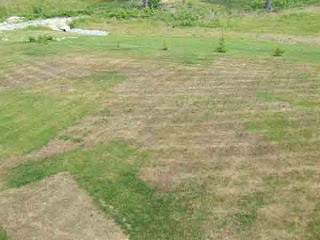Sun-Burned Lawn


This also happened last summer so I’m trying to come up with a plan to fix the problem. Our yard has two distinctly different soil types. When we excavated for the foundation we noticed that the front yard is full of very dense blue clay. However, the back yard was just like the beach, nice clean granular “beach” sand. Knowing that was the situation I decided to dig some shallow test pits.
I found that in the areas of really bad burning that the loam layer was really thin. In some cases only an inch deep. It’s been my experience that you need at least 3 inches of soil and 4 or 5 would be great. The thin soil layer is a problem for me for two reasons. One the thin layer only allows the grass roots to grow to a shallow depth, thus needing water more often. The other problem is the really fine granular sand below the soil is acting like a sponge and wicking all the water away from the grass roots.
When we built this house we tried to save all the existing loam (woods dirt) that was on site, it was bulldozed off and then screened. The problem with that was there wasn’t a huge amount of loam to properly do the site and the soil acidity was really bad. The good thing is we didn’t have to purchase additional loam at that time.
My proposed solution to the problem will take place this fall. I plan on spreading two more inches of loam in all the areas that have been burning really bad. I’ll have to buy a couple of loads of good loam and then I’ll probably do the work by hand. Good loam is typically a ratio of 40% silt, 20% clay and 40% sand and organic matter. Most garden centers sell loam by the truck load which is much cheaper than buying it by the bag. Then I’ll seed it with a good sun tolerant and drought tolerant seed.
Recent Posts
Framing Stick Nailer vs Coil Nailer
Which is Better a Stick Nailer or Coil Nailer? Framers have many choices in nailers…
How Many Roofing Nails Per Square of Shingles
Estimating How Many Nails for a New Roof When it comes to estimating materials for…
Composite / PVC Decking – Layout Tips & Advice
Composite / PVC Decking Layout Tips and Advice Composite and PVC decking have really changed…
Benefits of an ERV System (Energy Recovery Ventilator)
Benefits of ERV Systems (Energy Recovery Ventilator) If you're building a new home or doing…
Vermiculite Attic Insulation Abatement
Vermiculite Attic Insulation If your home was built before 1990 there is a chance it…
Nuisance Tripping of AFCI (Arc Fault) Circuit Breakers
Arc Fault (AFCI) Circuit Breakers Tripping Often An arc-fault circuit interrupter (AFCI) or arc-fault detection…


